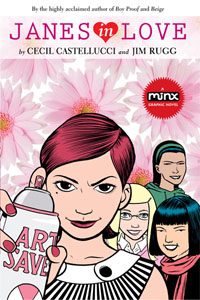 Here’s all the stuff I wanted to say about the Minx shut-down yesterday, but didn’t.
Here’s all the stuff I wanted to say about the Minx shut-down yesterday, but didn’t.
I didn’t really want to armchair quarterback this one, I think it’s unfortunate that it happened and the soundbite that everyone grabbed from my post yesterday (“I don’t think the rise or fall of this line says anything at all about the validity of comics for girls”) is what I want my defining statement on this event to be… But I figure this is all stuff that I’ve said at a bar (and yeah, I go to bars with my publishing industry friends and we drink and talk about the comics industry…) so I should probably man up and say them here. Here’s my thoughts on why I think Minx folded, and what I think had nothing to do with it:
1. It actually had really good, wide marketing.
I know, it’s weird, a lot of dudes are like “I never saw any marketing for it!” and the assertion, can’t remember where I saw it, that any failure like this is ultimately a failure of marketing, well I think that’s bogus. I’ve seen advertisements for Minx books on websites and in actual print magazines aimed at the target audience of YA girls. I know outreach and promotion was done to YA librarians, and there’s been substantial discussion of the line and of individual books on librarian-oriented listservs, both negative and positive, but the awareness was there. Racking is always a problem, everywhere, but I’ve read first-hand accounts over the last 24 hours of the books being racked in graphic novels and not working, in YA fiction and not working, in libraries and not working… The product was available and the right people knew about it, including the target market.
I will say that the DM seemed to get everything the mainstream market did, and then some, but that’s just because DM retailers are greedy and easily offended, particularly when it comes to perceived imbalances between attention given by DC Comics to the Direct Market and big-box stores… I understand where the idea that the Minx books were only ever advertised in the Direct Market comes from, but first hand, I can tell you that’s false.
Now clearly, the marketing wasn’t effective enough to overcome resistance to the product, but the marketing was both present and clear indicator of what the product was.
 2. The books actually were quite well-supported by DC Comics, up until they weren’t.
2. The books actually were quite well-supported by DC Comics, up until they weren’t.
I stand by my statement from yesterday; it’s incredibly unprofessional to drop a publishing line with promise after only a couple of seasons, and I honestly can’t believe that the folks at Vertigo didn’t stipulate a longer set-time period for the line in the mandate they received from DC… unless they did and DC just renegged, in which case… yikes.
But that said, DC really were behind this line and these books. Yesterday Heidi had “I know from many conversations that the Minx line wasn’t very popular with the rank and file of DC,” and that’s my experience as well, but so what? Everyone at DC in the sales department was (in my observation) entirely professional in my dealings with them in regards to the Minx line. They pushed the books like they should; they gave the Direct Market a really, really great ordering incentive on the books, offering full returnability on unsold copies… They got behind each release every week in the same way they did with everything else, and the worst thing I ever heard someone from DC say about the books is “They’re not really my thing…” which is actually kind of refreshing to hear, coming from a twenty- or thirty-something man. AND they were quick to follow-up with “But I’ve read them and I some of them are strong, I think there’s an audience,” because in the end they’re sales reps and that’s their job, to sell stuff. I never felt, as a retailer or as a book-industry observer, that the publisher wasn’t 100% behind these books.
Beyond that, we’ve all heard the figures thrown around for the dollars spent by Warner and DC to make this line a hit, and I think Dirk’s theory about the line collapsing under the weight of its budget is solid. We’ll never know, honestly, because the official DC response is pretty clear that no blame will be laid anywhere. Maybe Paul Levitz will let something slip in an interview 5 years from now.
 3. Minx was no half-hearted push into the YA section of the bookstores, it was not a cynical attempt to cash in on the manga market.Â
3. Minx was no half-hearted push into the YA section of the bookstores, it was not a cynical attempt to cash in on the manga market.Â
Despite comments made by Shelley Bond at the outset of the line that she really wanted those manga readers to read comics that she liked better (that still sends chills up my spine, hearing that), Warner Brothers is not creating 14-20 graphic novels based on Shelley Bond’s whim, period.
Everyone up the line thought they had a chance to capture some of the market that had been newly created for comics for teen girls. If you’re going to excoriate Minx for that fact, then you better line up a lot of other pubs as well, including Viz, Tokyopop, and Del Rey. Everyone, everyone wants to be the ones producing the books that the massive demographic-swell of teenage boys and girls will read when they get “done” with shonen/shoujo manga. I could sit here all day and explain all of the initiatives that many publishers have undertaken to be the ones who publish what’s next. I won’t. I already have. Good on DC for throwing their hat into the ring, instead of just cedeing a whole generation to another publisher, or group of pubs, or style of material.
There was nothing half-hearted about Minx, everyone involved put a lot of energy into this.
4. So What.
Here’s where I make friends with everyone (note: sarcasm).
All the good intentions in the world don’t amount to much without the ability to back them up.
Put as politely and delicately as possible, to the best of my knowledge the vast majority of editorial staff, publishing staff, and creative staff, had little to no experience producing material for a Young Adult audience. I honestly don’t know what made them think that they could, actually. Everyone I’ve talked to in Children’s and Teen publishing has pointed out similar problems with the line, and all of it belies a real lack of understanding of how YA publishing works.
I’ve seen a lot of railing on the quality of the books here, particularly from teachers and librarians who are normally advocates for graphic novels, and that really oughtta tell you something.
That a diverse group of people (commentators? pundits?) can put together a list of the same 4 or 5 Minx books that were “pretty good” or “all right” while everyone excludes the rest, that’s telling too.
That those 4 or 5 books come from folks with a good deal of work under their belts creating material for the target audience? Close the book on it.
I applaud the effort expended by the creators and staff on these books, but David Welsh’s comment is probably the most apt: “My strongest impression of the Minx books I’ve read… is that they felt incomplete, that they were at least two rigorous edits away from being a finished piece of entertainment.” Those books were edited, David. They edited the hell out of those books, at least in some cases. But editing and producing books for a young adult audience is a very specific skill, and one that is coveted by some of the biggest publishers in the industry. I would be frankly shocked if someone could go from editing a fantasy-informed mature readers single-issue comic book line with a 60/40 male/female audience split for a number of years and then just pick up and start running a teen-girl oriented young adult original graphic novel line without a hiccup.
I think it’s clear that there were hiccups.
I think the difference between P.L.A.I.N. Janes and the newly released Janes In Love show that the creators and editors alike were learning on the job, how original graphic novels for a teen girl audience might work.
And I think it’s too bad that it’s over so soon.
—
Ending on a positive, here’s an anecdote for you about the MINX books.
We stocked every Minx graphic novel fairly deeply, at least 20 copies on each book. The books did fairly well for us, comparing well with mid-tier and lower-tier manga. The books were cross-racked between floors at various points, and the newest one always had a full-face display in our kids/teen area.
Last week, we repurposed some of fixtures to give more attention to graphic novels, and as part of the repurposing we ended up creating a rack that had all of our in-stock MINX (as well as other digest-sized teen-friendly graphic novels) with full-faces. The books have a line-wide design that I’m not a fan of, but racked all together, full face (something that rarely-if-ever happens in retail) they made for a nice display. Monday morning two young ladies came in, right in the MINX target demo, and headed to look at the books that would normally be of interest to them when they spotted the new display. After 15 minutes of browsing the books, they came to the front counter and had chosen two MINX titles out of the hundreds in their immediate area.
They looked like manga-fans, they shopped through an entire area dedicated to teen graphic novels, and those two books were what caught their eye. We might never know if they liked them or not, but those books did attract the audience they were supposed to, even if in a direct market comic book store.
That’s pretty good.
– Christopher


“But editing and producing books for a young adult audience is a very specific skill, and one that is coveted by some of the biggest publishers in the industry.”
I think you just hit the head on the nail. I couldn’t imagine DC not editing these books, but I did wonder what kinds of editors they had for them. YA fiction, especially girls’ YA fiction, is so drastically different in tone and dialog and pacing from your traditional DC fare and should be cared for by editors who love and have experience the genre.
Did Minx have a dedicated editorial staff or were they shared with the regular DC staff?
Minx cancellation sux! I loved reading those books (quick reads, some nice stories if never very inventive art) and agree that DC had no idea how to manage/sell to a YA audience. In a sort-of related question, is The Devil’s Panties still going? I don’t see it on the online comix list and I really miss it… Have an awesome TCAF (wish I could be there… but I’m in London paying huge overcharges on US imports, blech) and — ooh, could you pass on a call for submissions (we want single image and comic art as well!)
“Issue 11: Utopia
Deadline 15 June 2009
Guest Editor: Sophie Mayer
From Margaret Cavendish’s “blazing world” in the seventeenth century to Time Agent Captain Jack Harkness in the fifty-first, the places and people of speculative fiction have given writers and artists an opportunity to speculate about new forms of gender and sexuality — going beyond queer, pansexuality and transsexualities to imagine the identities and desires of humanoid, post-human and non-human lifeforms. While the culture of mainstream SF, fantasy and comics has often been hostile to women, queer people and people of colour, brilliant science fiction writers since the 60s have aroused, mirrored and incited feminist and queer social revolutions and artistic development — think of Joanna Russ’ The Female Man, Star Trek slash fiction, Samuel Delany’s polymorphous postmodern fictions or Kate Bornstein’s cyberpunk erotica.
How would condoms work in zero G? And (because it’s not only the future that’s queer) what would happen in Dracula got cosy with Lucy’s suitors instead? Your imagination (and, in some cases, the laws of physics) are the only limits… Stories, poems, comics, drawings, photographs – if it fits into a journal, we want to see it.”
http://www.chromajournal.co.uk/#/utopiaissue/4530952834
Email: chroma.utopia@yahoo.co.uk for more information.